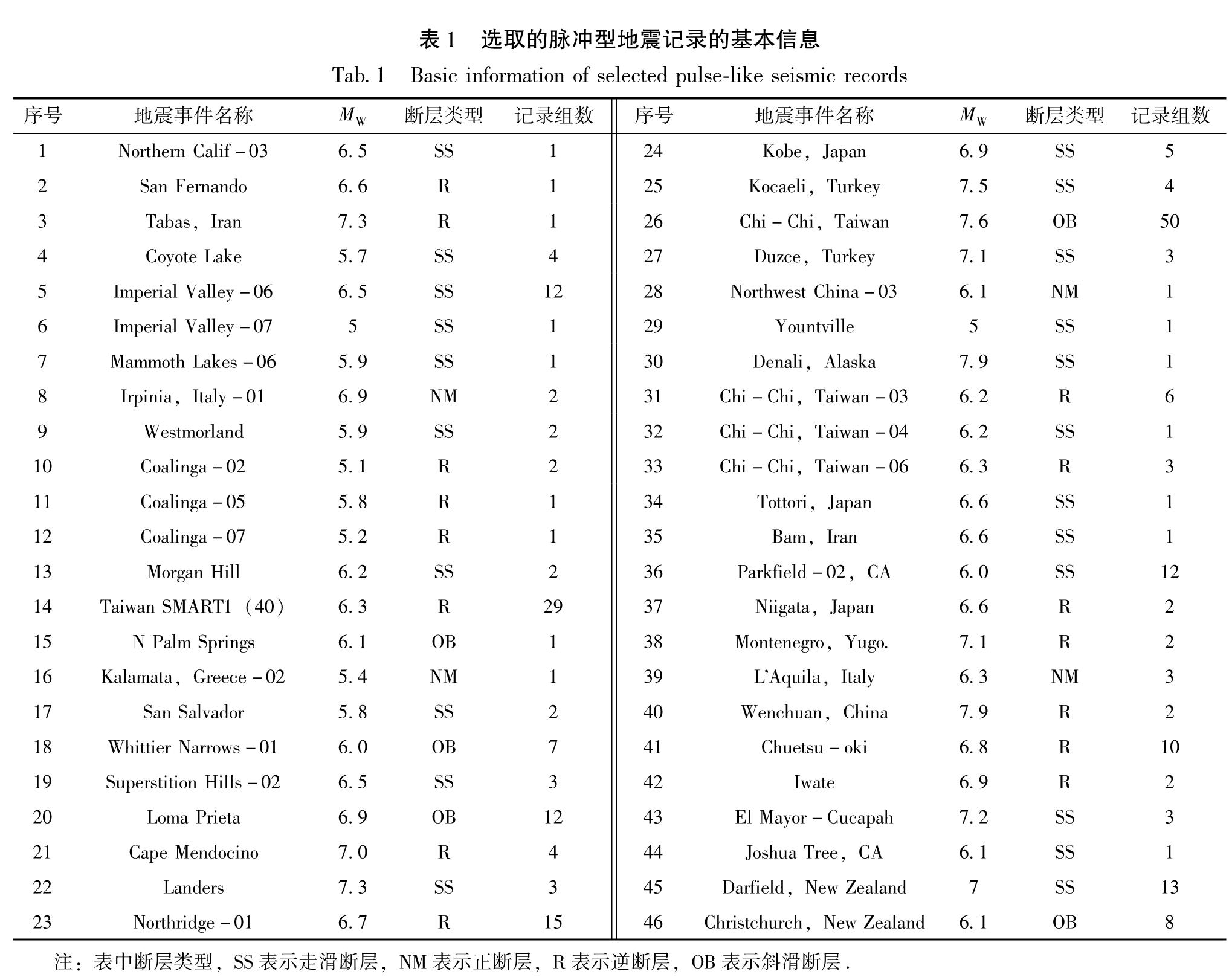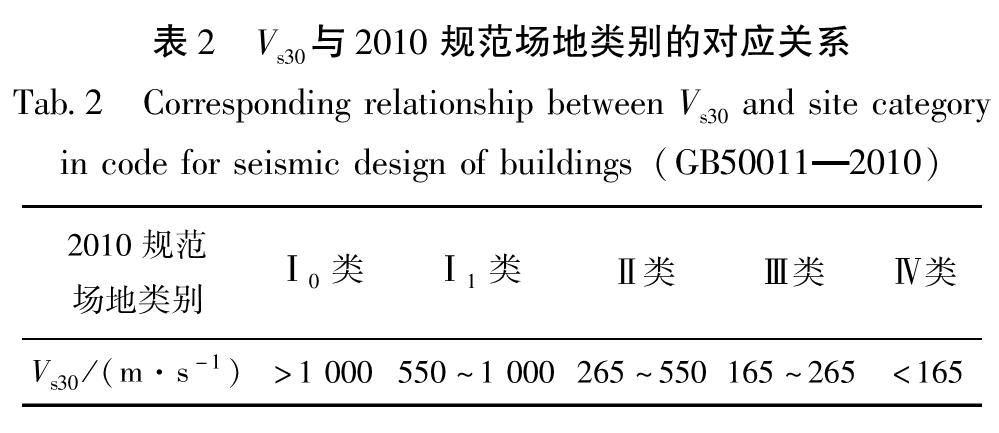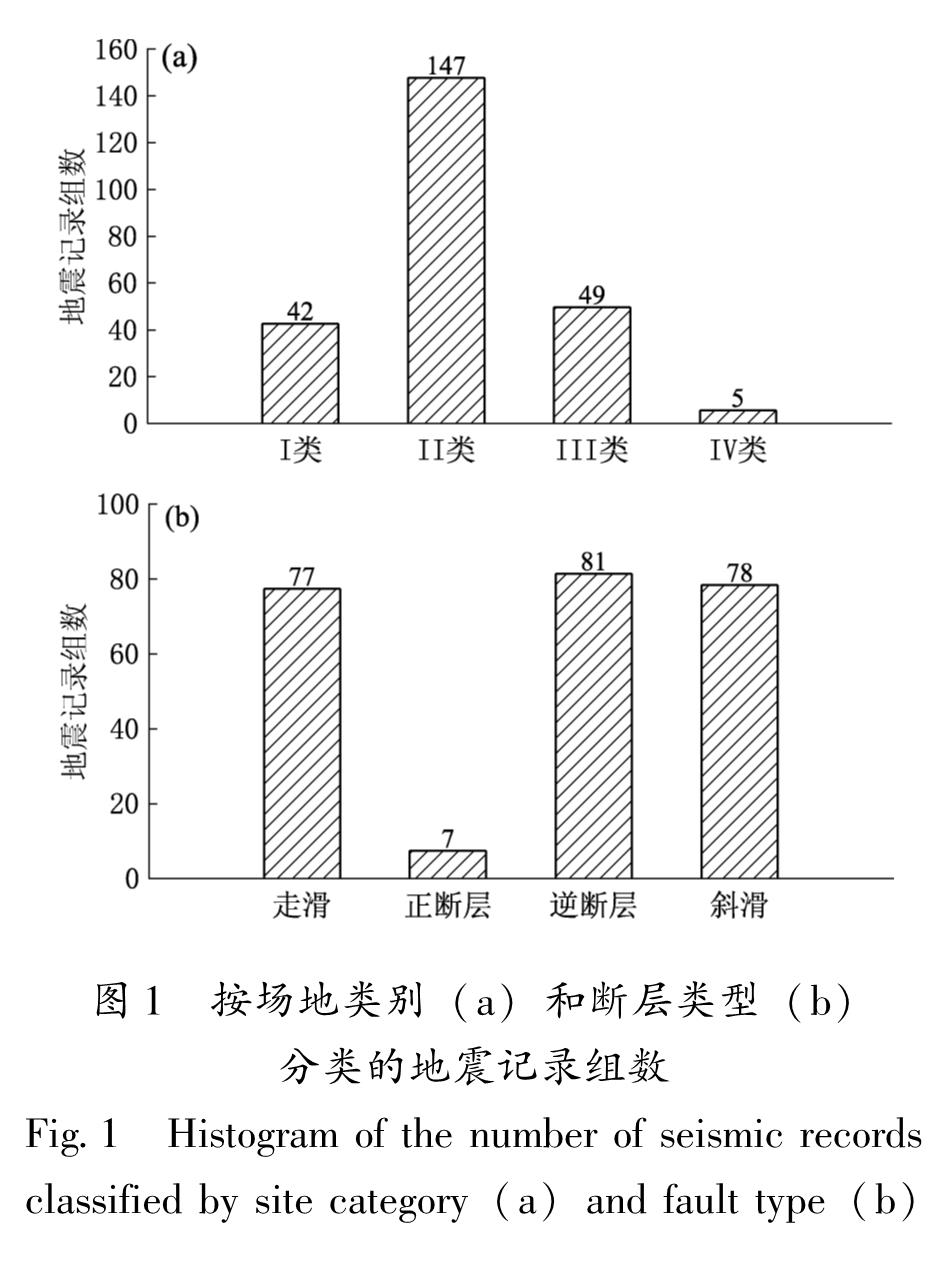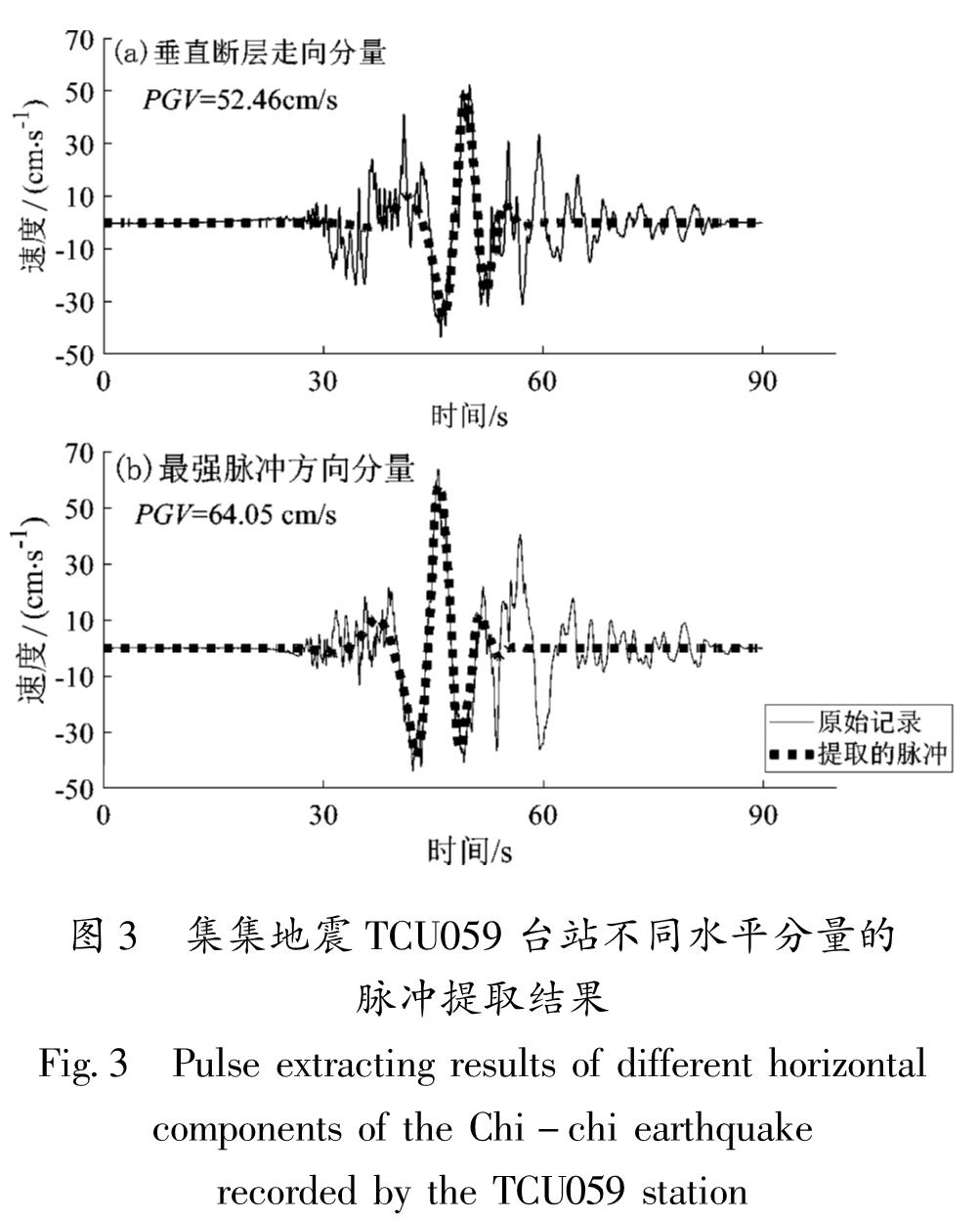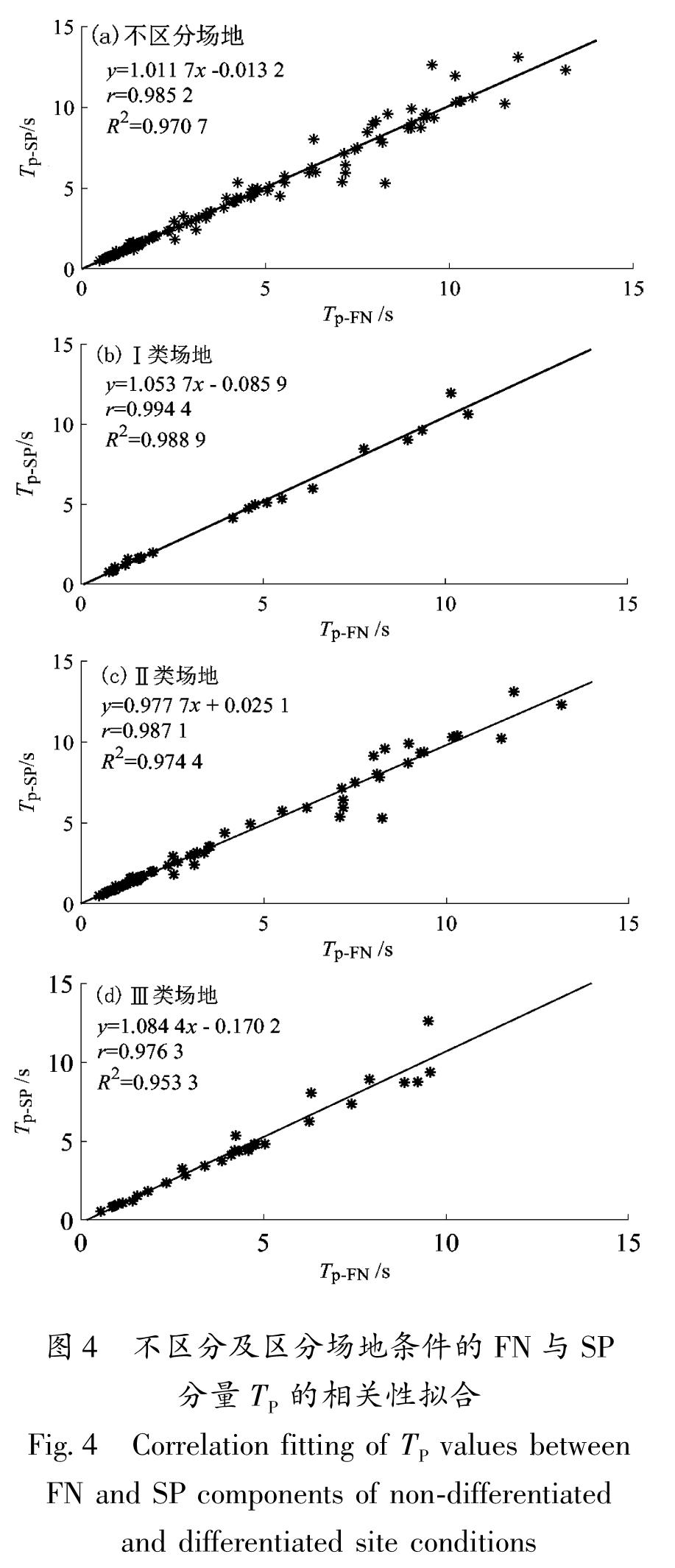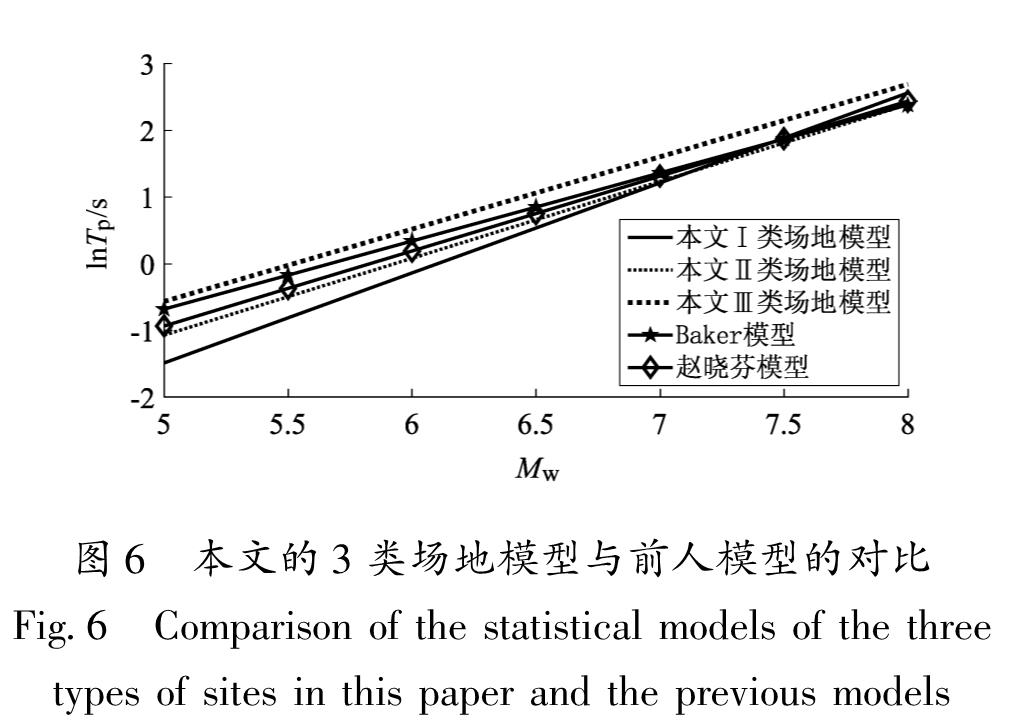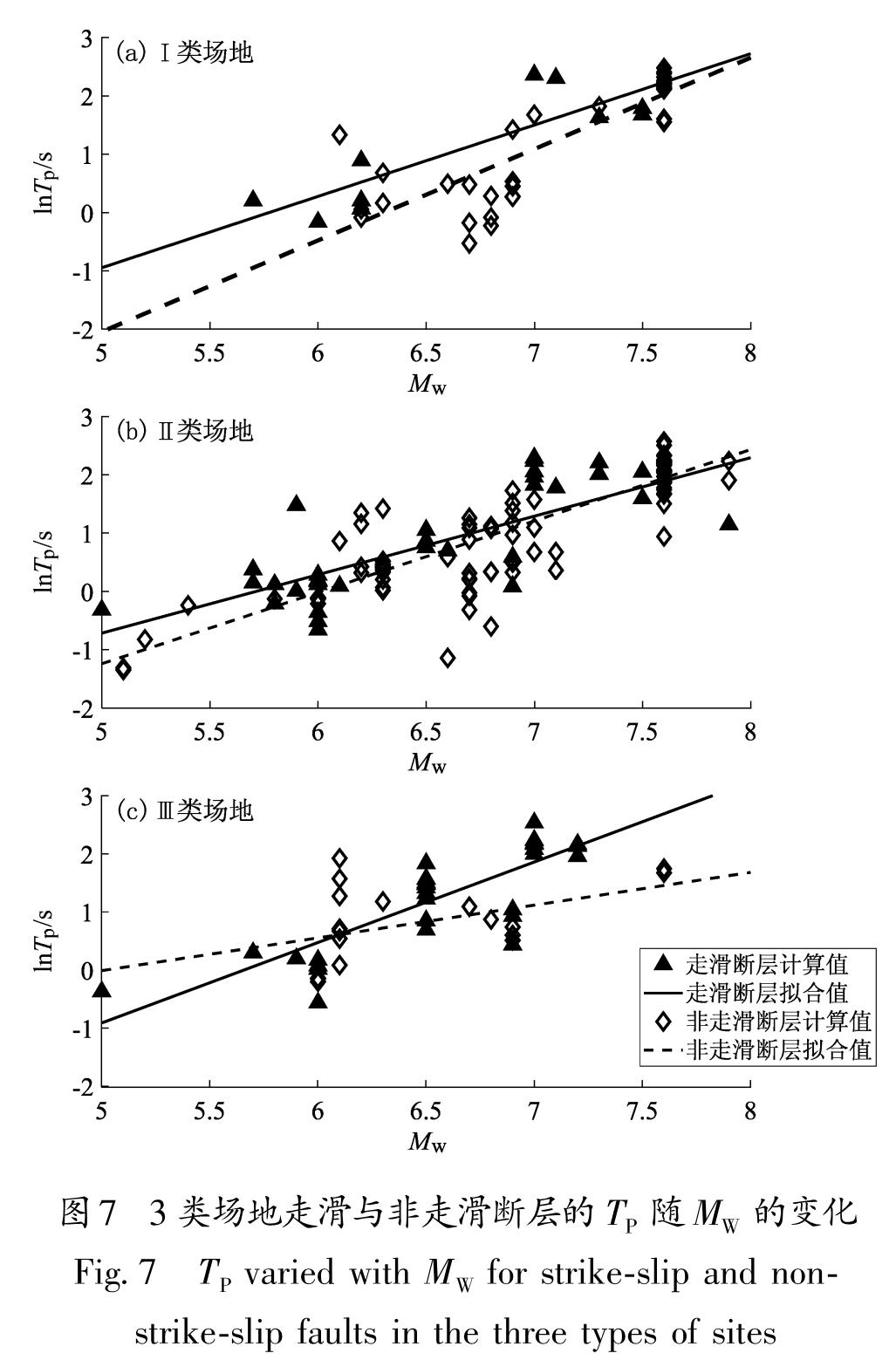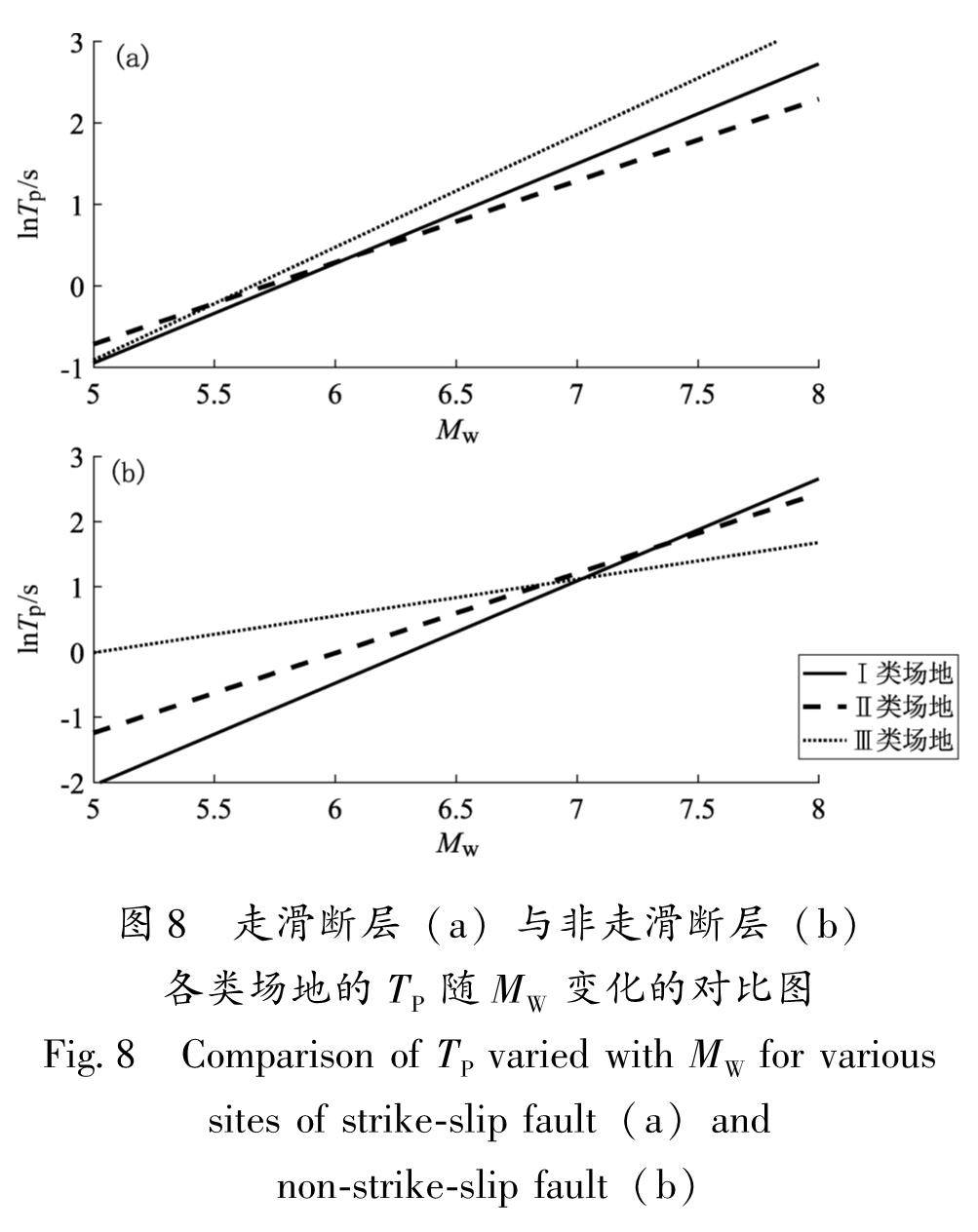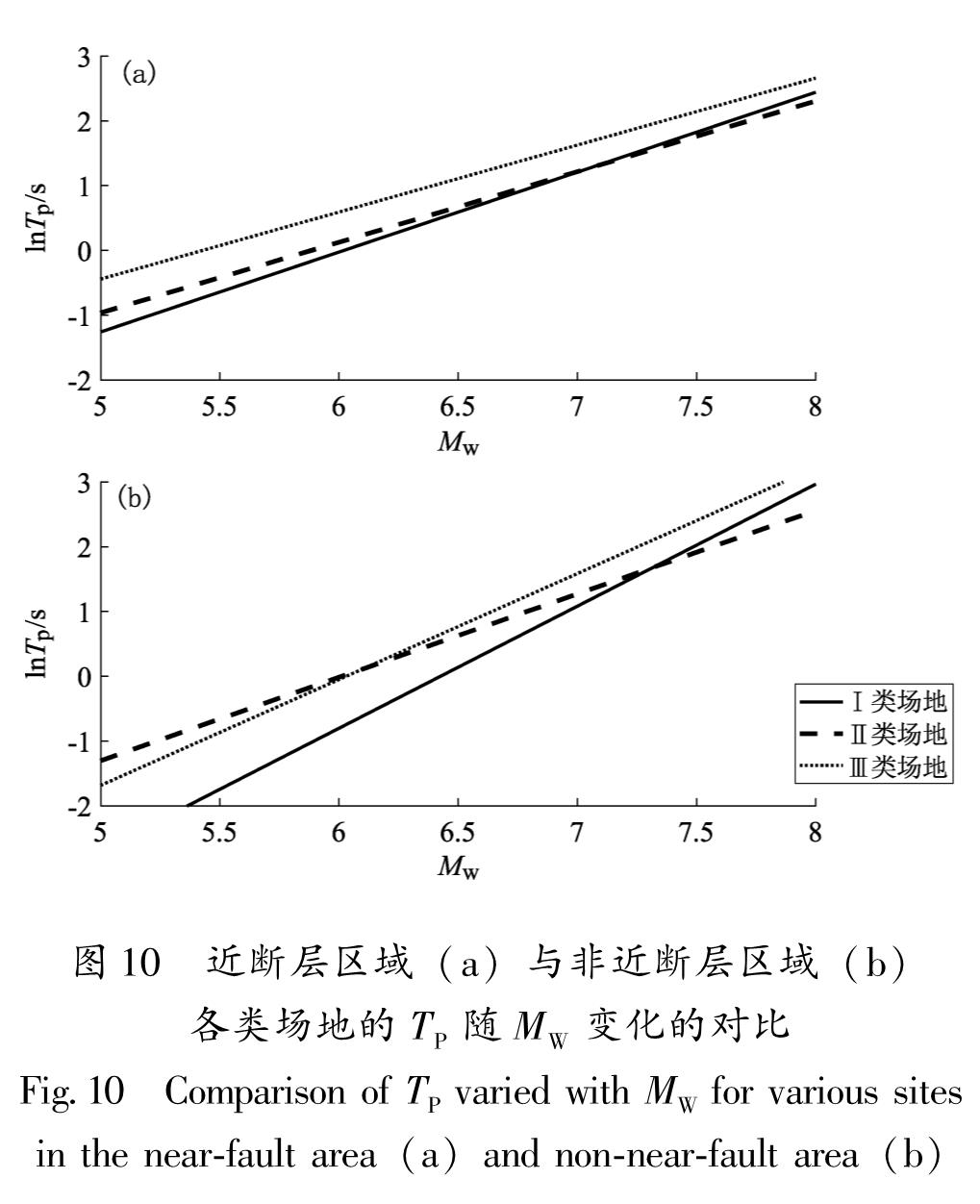基金项目:国家自然科学基金(51969019,51468045)、水利部公益性行业科研专项(201401009)、江西省教育厅科技项目(GJJ160703)和南昌航空大学研究生创新专项资金项目(YC2018067)联合资助.
(1.南昌航空大学 土木建筑学院,江西 南昌 330063; 2.杭萧钢构股份有限公司,浙江 杭州 310003)
(1.Department of Civil Engineering,College of Civil Engineering and Architecture,Nanchang Hangkong University,Nanchang 330063,Jiangxi,China)(2.Hangxiao Steel Structure Co. Ltd.,Hangzhou 310003,Zhejiang,China)
strongest pulse direction component; pulse period; site conditions; magnitude; fault type; fault distance
备注
基金项目:国家自然科学基金(51969019,51468045)、水利部公益性行业科研专项(201401009)、江西省教育厅科技项目(GJJ160703)和南昌航空大学研究生创新专项资金项目(YC2018067)联合资助.
以NGA-West2强震数据库中的243组脉冲型地震记录为数据基础,按照我国场地分类标准对其进行分类,探讨场地条件、断层类型及断层距等对最强脉冲方向分量脉冲周期(TP)随震级(MW)变化规律的影响。结果 表明:①最强脉冲方向分量与垂直断层走向分量的TP具有强线性相关性,场地条件对二者周期相关性的影响不大; ②场地土层的剪切波速越大,TP随MW增大的速率越快; ③Ⅲ类场地的TP值大于Ⅰ,Ⅱ类场地; ④最强脉冲方向分量TP随MW的增大速率要快于垂直或平行断层走向分量; ⑤在Ⅰ,Ⅱ类场地条件下,非走滑断层的TP随MW的增大速率快于走滑断层,这一规律在Ⅲ类场地条件下正好相反; ⑥3类场地非近断层区域的TP随MW的增大速率快于近断层区域。建议在使用脉冲周期与震级关系的统计模型时应考虑场地条件、断层类型、断层距及不同国家场地分类标准差异性的影响。
Based on the 243 sets of pulse-like seismic records in the NGA-West2 strong earthquake database,we classified the selected seismic records according to the site classification standards of China,and discussed the influences of site conditions,fault types and fault distance on the variation of pulse period TP in the strongest pulse direction with magnitudeMW.The results show that:① The TP in the strongest pulse direction has a strong linear correlation with the TP in vertical fault strike direction,and the site conditions have little effect on the correlation between the two component pulse periods.② The greater the shear wave velocity of foundation ground,the faster the TP increases with the increasing of MW.③ The predicted value of the pulse period of the class III site is greater than that of the class I site and class II site.④ TP of the strongest pulse direction component increases faster with the increasing of MW than that of the vertical or parallel fault strike component.⑤ Under the conditions of class I and II sites,the TP of non-strike-slip faults increases with the increasing of magnitude faster than that of strike-slip faults.This rule is exactly the opposite under the conditions of class III site.⑥ The TP of class I,II and III sites in non-near-fault area increases with the increasing of MW faster than that in near-fault area.It is recommended that we should consider the effects of site conditions,fault types,fault distance and differences of site classification standards in different countries when using a statistical model of the relationship between pulse period and magnitude.
引言
脉冲型地震动对工程结构的强烈破坏作用已引起了地震工程研究者们的广泛关注,深入研究其地震动特性对揭示速度脉冲产生机理以及开展工程结构的抗震设防具有重要意义。典型的速度脉冲特性是脉冲型地震动区别于其他地震动的显著特征,也是引起结构发生严重破坏的重要原因(徐星辰,2016)。脉冲周期作为表征速度脉冲特征的主要参数一直以来都备受重视,其对工程结构的显著影响作用也已被大量研究工作所证实(江辉等,2015; Khoshnoudian,Ahmadi,2013; 王博等,2019),尤其是对长周期构(建)筑物,如超高层建筑、大跨度桥梁、大型储液罐等影响显著。
对地震记录进行统计分析是当前研究地震动特性最常用的方法,随着脉冲型地震记录的获取和积累,开展脉冲周期的统计分析成为了可能。Somerville(2003)建立了不同场地条件下脉冲周期随震级的变化关系,分析得出土层场地的脉冲周期略大于基岩场地; 韦韬等(2006)对比分析了有无速度脉冲近断层记录的反应谱和特征周期,结果表明在长周期段,有速度脉冲记录的反应谱值大于无速度脉冲记录,并且速度脉冲记录的特征周期值大于我国规范Ⅰ,Ⅱ类场地的特征周期; 孙亦鸥(2014)与王宇航(2015)根据断层类型和场地条件对近断层脉冲型地震记录进行分类,回归得到了不同分类情形下的脉冲周期随震级变化的经验公式。然而,目前关于场地条件对脉冲周期影响的研究大多都是根据美国抗震设计规范进行场地分类,关于我国场地分类标准下脉冲周期的影响因素研究还很少,这不利于脉冲周期的研究成果在我国的推广应用。因此,有必要深入探讨我国抗震设计规范场地分类标准下脉冲周期的有关特性。
脉冲型地震动存在显著的方向性特征,常志旺(2014)研究认为,不同方向上的脉冲特性存在差异; Howard等(2005)曾将脉冲型地震动的加速度反应谱峰值(Samax)所对应方向定义为最强脉冲方向,但这并未很好地反映出速度脉冲的幅值特性; Shahi和 Baker(2014)定义连续小波变换中最大小波系数所对应的方向为最强脉冲方向,该定义更为全面地反映出地震动的速度脉冲特性; 陈志强等(2018)研究表明:结构在最强脉冲方向上的地震反应明显大于其它的水平方向。但以往关于速度脉冲特性的研究大多是基于垂直和平行断层走向或不考虑方向性的情形开展的(Baker,2007; 谢俊举等,2012; 罗全波等,2018; Luo et al,2019); 或是未深入分析场地条件、断层类型、断层距等因素对脉冲周期的影响规律(赵晓芬等,2018)。鉴于此,本文从NGA-West2强震数据库中选取243组脉冲型地震记录,基于连续小波变换识别出每组地震记录的最强脉冲方向分量并确定其脉冲周期,分析垂直断层走向和最强脉冲方向分量脉冲周期的相关性,探讨我国场地分类标准下的场地条件、断层类型以及断层距对最强脉冲方向分量脉冲周期随震级的变化规律的影响。
1 脉冲型地震动记录选取
本文从NGA-West2强震动数据库中选取46个地震事件共计243组脉冲型地震记录,基本信息见表1。这些地震震级MW为5.0~7.9,断层距R为0.1~92.7 km,场地剪切波速Vs30为139.21~2 016.13 m/s。美国抗震设计规范以地表以下30 m的等效剪切波速Vs30作为场地分类依据,而我国《建筑抗震设计规范》(GB50011—2010)(2016版)(以下简称“2010规范”)规定根据覆盖层厚度和土层等效剪切波速来确定场地类别,且依据覆盖层厚度和地表以下20 m深的较小值确定等效剪切波速的计算深度。显然,两国在场地分类依据方面存在差异性。
为了与我国抗震规范的场地划分方式相协调,以便于本文的脉冲周期的研究结果在我国实际工程中的推广使用,本文选用郭锋等(2011)给出的美国规范对应的Vs30与2010规范规定的场地类别的对应关系,见表2。将选取的脉冲型地震记录按照断层类型和我国的场地类别进行分类统计,结果如图1所示。由图1a可见,由于Ⅳ类场地台站数太少,为避免统计分析时由于数据较少而产生较大误差,本文只对Ⅰ,Ⅱ和Ⅲ类场地展开分析。
表2 Vs30与2010规范场地类别的对应关系
Tab.2 Corresponding relationship between Vs30 and site category in code for seismic design of buildings(GB50011—2010)2 最强脉冲方向分量识别
2.1 脉冲型地震动的方向性特征1组实测地震记录通常包含1条竖直记录分量和2条相互垂直的水平记录分量,对其中2条水平记录分量按照平行四边形法则进行旋转变换,可得到任意水平方向的地震动分量,计算式如下(Boore,2010):
f(t,θ)=f1(t)cosθ+f2(t)sinθ(1)
式中:θ为两水平记录方向以顺时针方向旋转的角度; f(t,θ)为旋转角θ对应的旋转地震动分量; f1(t), f2(t)为相互垂直的两水平记录分量。
以中国台湾集集地震TCU059台站(以下简称“TCU059台站”)为例,对其EW和NS向2条水平分量按式(1)进行旋转变换,可得到不同水平方向的地震动分量,其速度峰值(PGV)的空间分布如图2所示。从图中可以看到,脉冲型地震动不同水平方向上的PGV具有明显差异,PGV最大值甚至高出PGV最小值45%左右。此时若在结构抗震分析中选用较小PGV所对应的方向分量作为地震动输入,将严重低估结构的地震响应。
2.2 基于连续小波变换的最强脉冲方向分量识别脉冲型地震动具有明显的方向性特征,本文采用Shahi和Baker(2014)提出的基于连续小波变换的多分量速度脉冲识别方法进行最强脉冲方向分量的识别,该方法定义连续小波变换过程中最大小波系数对应的方向为最强脉冲方向。具体的计算步骤如下:
① 对两个相互垂直的水平速度记录分量f1(t)和f2(t)按式(1)进行线性组合,得到水平任意方向速度分量f(t,θ), 对f(t,θ)进行连续小波变换,其小波系数为:

式中:c(s,l,θ)为f(t,θ)的小波系数; φ是母小波函数; s是扩展小波的尺度参数; l是小波变化时间尺度上的位置参数。
② 将式(1)代入式(2)可得任意方向的小波系数为:

③ 式(3)又可变换为:
c(s,l,θ)=c1(s,l)cos θ+c2(s,l)sin θ(4)
式中:c1(s,l), c2(s,l)分别为f1(t), f2(t)的小波系数。
小波系数的最大值为:

④ 最大小波系数所对应的方向β为:

β方向即为脉冲型地震动的最强脉冲方向,将水平记录分量按照式(1)旋转到该方向,即可得到最强脉冲方向分量。以TCU059台站为例,经计算求得该台站记录到的脉冲型地震动的最强脉冲方向β=45.41°,其空间取向如图2所示。从图中可以看出,该台站最强脉冲方向与PGV最大值所对应的方向基本重合。
基于连续小波变换,对选取地震记录的最强脉冲方向分量提取长周期脉冲信号,其中TCU059台站最强脉冲方向分量脉冲提取结果及其与垂直断层走向分量的对比如图3所示。
图3 集集地震TCU059台站不同水平分量的脉冲提取结果
Fig.3 Pulse extracting results of different horizontal components of the Chi-chi earthquake recorded by the TCU059 station脉冲周期(TP)由母小波的最大傅里叶幅值对应的周期所确定(Baker,2007)。由图3可知,该台站最强脉冲方向分量的PGV和Tp大于垂直断层走向分量,说明脉冲型地震动的最强脉冲方向并不总是出现在与断层走向垂直的方向上,并且这两个方向分量的速度时程和脉冲特性可能存在较大差异。
3 不同水平分量脉冲周期的相关性分析
为了探究不同水平分量TP的关系,对最强脉冲方向(strongest pulse direction component,记为SP)分量和垂直断层走向(fault-normal component,记为FN)分量进行相关性分析,以相关系数r的大小来表示两者的相关程度。为更好地反映FN与SP分量Tp的线性相关性,采用式(7)线性关系式进行回归拟合,并利用式(8)计算回归方程的拟合优度R2以推断拟合效果(盛骤,谢式千,2004)。

式中:a、b为回归系数; yi、y^i分别为第i个原始数据和拟合数据; y^-表示原始数据的均值。
由于本文选取的强震记录的FN分量并不一定都是脉冲型记录,需先进行脉冲型记录的判别。将各组地震记录旋转到FN方向,参考Baker(2007)对NGA-West2强震动数据库地震记录的分类方法,计算其中满足脉冲型记录条件的135条FN分量的TP用于相关性分析。
图4为不区分及区分Ⅰ、Ⅱ和Ⅲ类场地条件下FN与SP分量TP的相关性统计结果。从图中可看出,无论是否区分场地类别,FN与SP分量的TP均具有强线性关系,相关系数r均大于0.95,R2均达95%以上。比较不同场地条件下FN与SP分量TP的相关性可以发现,Ⅰ类场地条件下的相关性略强于Ⅱ类和Ⅲ类场地,Ⅲ类场地条件下的相关性稍弱于Ⅱ类场地,这表明场地越软,相关性越弱。总体来说,场地条件对FN与SP分量TP的相关性的影响不太明显。除Ⅱ类场地条件下a小于1以外,其余场地条件下的a均大于1,说明Ⅱ类场地条件下SP分量TP随FN分量TP的变化速度要慢于Ⅰ,Ⅲ类场地。
图4 不区分及区分场地条件的FN与SP分量TP的相关性拟合
Fig.4 Correlation fitting of TP values between FN and SP components of non-differentiated and differentiated site conditions4 脉冲周期随震级的变化规律分析
4.1 不同场地类别已有研究证实,脉冲周期(TP)与矩震级(MW)呈现对数线性相关(Baker,2007; Shahi,Baker,2014; 赵晓芬等,2018)。为了揭示多类场地的SP分量TP随MW的变化规律,采用式(9)进行回归分析:
lnTp=a+b·Mw+ε(9)
式中:a,b为回归系数; ε为表示误差的随机变量,用回归标准差σ表示。
3类场地的TP随MW变化的回归系数见表3,拟合结果及其残差如图5所示。
表3 不同场地类别对应的TP随MW变化的回归系数
Tab.3 Regression coefficient of TP varied with MW in different sites图5 3类场地的TP随MW变化的拟合结果(a)及拟合残差(b)
Fig.5 Fitting results of TP varied with MW in three types of sites(a)and their residuals(b)由表3和图5可知,不同场地类别的TP均随MW的增大而增大。但3类场地的TP随MW增大的速率存在差异,其中Ⅰ类场地最快,Ⅲ类场地最慢,Ⅱ类场地介于Ⅰ、Ⅲ类场地之间,说明场地越硬、场地剪切波速越大,TP随MW增大的速率越快,这与谢俊举等(2017)的研究结果基本一致。随着MW的增大,Ⅲ类场地的TP拟合值始终大于Ⅰ、Ⅱ类场地,但由于Ⅲ类场地TP随MW增大的速率最慢,随着MW的增大,Ⅲ类场地与Ⅰ,Ⅱ类场地的TP拟合值差异逐渐缩小。当MW≤7.1时,Ⅱ类场地TP拟合值大于Ⅰ类场地,当MW>7.1时,正好相反。
从图5b可以发现:随着MW的增大,Ⅱ类场地TP拟合残差在零线两侧的分布较Ⅰ、Ⅲ类场地更为均匀。Ⅰ类场地TP拟合残差在MW<6.5和MW≥7.0时大多为正,在6.5≤MW<7.0时大多为负,说明Ⅰ类场地TP实测值在MW<6.5和MW≥7.0时偏大,在6.5≤MW<7.0时偏小。Ⅲ类场地TP拟合残差在MW≤6.0和6.5<MW≤7.0时大多为负,在6.0<MW≤6.5和MW>7.0时大多为正,说明Ⅲ类场地TP实测值在MW≤6.0和6.5<MW≤7.0时偏小,在6.0<MW≤6.5和MW>7.0时偏大。造成Ⅰ、Ⅲ类场地的TP拟合残差在零线两侧分布不均匀的原因,一方面可能是Ⅰ、Ⅲ类场地的数据量偏少,另一方面可能是不同地震事件会受除震级以外的其他因素的影响,如断层类型、断层破裂速度、震源深度及传播路径等。
4.2 与其它模型的对比将本文回归得到的3类场地的TP随MW变化的统计模型与采用垂直断层或平行断层走向的脉冲记录的Baker(2007)模型(以下简称“Baker模型”以及采用最强脉冲方向的脉冲记录但不区分场地类别的赵晓芬等(2018)模型(以下简称“赵晓芬模型”)进行对比,结果如图6所示。
图6 本文的3类场地模型与前人模型的对比
Fig.6 Comparison of the statistical models of the three types of sites in this paper and the previous models由图6可见,各模型中TP随MW的变化趋势一致,均表现为随MW的增大而增大,但不同模型TP随MW增大的速率存在差异,其中Baker模型最慢,这是Baker模型与其余模型的样本数据不同所致。Baker模型采用垂直或平行断层走向的脉冲记录,而其余模型则采用最强脉冲方向的脉冲记录,说明最强脉冲方向分量TP随MW增大的速率要快于垂直或平行断层走向分量。赵晓芬模型与本文模型均采用最强脉冲方向的脉冲记录,但本文模型按中国抗震规范区分了场地类别,这导致两者TP随MW的变化规律存在差异。赵晓芬模型中TP随MW增大的速率要快于本文Ⅲ类场地模型,但慢于Ⅰ、Ⅱ类场地模型。当MW<7.4时,Baker模型和赵晓芬模型的TP拟合值大于本文Ⅰ、Ⅱ类场地模型,但小于Ⅲ类场地模型,且随着MW的增大,Baker模型与Ⅰ、Ⅱ类场地模型的TP差异逐渐减小,与Ⅲ类场地模型的TP差异逐渐增大,而赵晓芬模型与本文3类场地模型的TP差异均有所减小。当MW≥7.4时,Baker模型、赵晓芬模型的TP拟合值与本文Ⅱ类场地模型比较接近,但小于Ⅰ、Ⅲ类场地模型。
4.3 断层类型由于Ⅲ类场地正断层和逆断层的地震记录分别只有1组和3组,且记录的震级均在6.0~7.0,所以本文将选取的地震记录按照断层类型划分为走滑断层和非走滑断层两类,其中非走滑断层包括正断层、逆断层和斜滑断层。3类场地走滑与非走滑断层的TP与MW的关系如图7所示。
图7 3类场地走滑与非走滑断层的TP随MW的变化
Fig.7 TP varied with MW for strike-slip and non-strike-slip faults in the three types of sites由图7可见,各种分类情形下TP均表现为随MW的增大而增大,断层类型对TP随MW的变化规律具有显著影响,其中在Ⅰ、Ⅱ类场地条件下,非走滑断层TP随MW增大的速率快于走滑断层,而在Ⅲ类场地条件下相反。在Ⅰ类场地条件下(图7a),走滑断层的TP拟合值始终大于非走滑断层; 在Ⅱ类场地条件下(图7b),当MW<7.4时,走滑断层的TP拟合值更大,当MW≥7.4时,非走滑断层的TP拟合值大于走滑断层; 在Ⅲ类场地条件下(图7c),当MW<6.1时,走滑断层的TP拟合值小于非走滑断层,当MW≥6.1时,走滑断层的TP拟合值更大。Mavroeidis(2003)研究认为走滑断层的TP大于逆断层和斜滑断层,这与本文Ⅰ类场地条件下的研究结果基本一致,但与Ⅱ、Ⅲ类场地条件下的研究结果存在一些偏差,可能是由样本数据及场地分类方法的不同所致。
图8为走滑和非走滑断层不同场地的TP与MW关系的对比图,由图可知:对于走滑断层(图8a),Ⅲ类场地TP随MW增大的速率最快,Ⅱ类场地最慢,Ⅰ类场地居中; 对于非走滑断层(图8b),Ⅰ类场地TP随MW增大的速率最快,Ⅲ类场地最慢,Ⅱ类场地居中。随着MW的增大,走滑断层不同场地的TP差异逐渐增大,而非走滑断层不同场地的TP差异呈先减小后增大的趋势。
图8 走滑断层(a)与非走滑断层(b)各类场地的TP随MW变化的对比图
Fig.8 Comparison of TP varied with MW for various sites of strike-slip fault(a)and non-strike-slip fault(b)4.4 断层距地震发生的近断层区域是震害最为严重的地区,为分析距离对TP随MW变化规律的影响,本文按照断层距将选取的地震记录划分为近断层(R<20 km)和非近断层(R≥20 km)两类。3类场地近断层与非近断层区域的TP随MW变化的定量关系如图9所示。由图可知,各种分类情形下TP均表现为随MW的增大而增大。断层距对TP随MW的变化规律具有较大影响,3类场地非近断层区域TP随MW增大的速率均快于近断层区域。在MW较小时,各类场地近断层区域的TP拟合值大于非近断层区域; 随着MW的增大,各类场地近断层与非近断层区域的TP差异逐渐减小; 当MW分别为7.2、6.7、7.0时,3类场地近断层与非近断层区域的TP拟合值相同; 在MW较大时,3类场地非近断层区域的TP拟合值大于近断层区域。
图9 3类场地近断层与非近断层区域的TP随MW的变化
Fig.9 TP of the three types of sites varied with MW in the near-fault and non-near-fault areas图 10为近断层与非近断层区域不同场地的TP随MW的变化关系对比图,由图可知:无论是在近断层还是非近断层区域,Ⅰ类场地TP随MW增大的速率均快于Ⅱ、Ⅲ类场地; 不同的是,在近断层区域,Ⅱ类场地TP随MW增大的速度快于Ⅲ类场地,而这一规律在非近断层区域刚好相反。在近断层区域,Ⅲ类场地的TP拟合值始终大于Ⅰ、Ⅱ类场地; 在MW<7.0时,Ⅱ类场地TP拟合值大于Ⅰ类场地,在MW>7.0时相反。在非近断层区域,Ⅲ类场地的TP拟合值始终大于Ⅰ类场地; 在MW<6.0时,Ⅱ类场地TP拟合值大于Ⅰ、Ⅲ类场地,随着MW的继续增大,Ⅲ、Ⅰ类场地的TP拟合值先后超过Ⅱ类场地。
图 10 近断层区域(a)与非近断层区域(b)各类场地的TP随MW变化的对比
Fig.10 Comparison of TP varied with MW for various sites in the near-fault area(a)and non-near-fault area(b)5 结论
本文利用NGA-West2强震数据库中的243组脉冲记录,探讨了最强脉冲方向分量与垂直断层走向分量脉冲周期的相关性,分析了场地条件、断层类型及断层距等因素对脉冲周期随震级变化规律的影响,主要得到以下结论:
(1)最强脉冲方向分量与垂直断层走向分量的TP具有强线性相关性,场地条件对两分量TP相关性的影响不大。
(2)不同场地条件下,最强脉冲方向分量TP随MW的变化趋势一致,均表现为随MW的增大而增大,但不同场地类别对其影响程度存在差异,具体表现为场地剪切波速越大,TP随MW增大的速率越快。Ⅲ类场地的TP拟合值始终大于Ⅰ,Ⅱ类场地,这可能与软土场地的放大作用有关; 当MW≤7.1时,Ⅱ类场地TP拟合值大于Ⅰ类场地,当MW>7.1时,Ⅰ 类场地TP拟合值大于 Ⅱ 类场地。
(3)最强脉冲方向分量TP随MW增大的速率要快于垂直或平行断层走向分量,不同场地类别对TP随MW的变化规律具有较大影响,建议在使用脉冲周期随震级变化的统计关系模型时,应考虑场地条件及不同国家场地分类标准差异性的影响。
(4)断层类型对最强脉冲方向分量TP随MW的变化规律的影响不可忽略。在Ⅰ、Ⅱ类场地条件下,非走滑断层TP随MW增大的速率快于走滑断层,这一规律在Ⅲ类场地条件下正好相反。随着MW的增大,走滑断层不同场地之间TP的差异逐渐增大,而非走滑断层不同场地之间TP的差异呈先减小后增大的趋势。
(5)断层距对最强脉冲方向分量TP随MW的变化规律具有显著影响,3类场地非近断层区域的TP随MW增大的速率要快于近断层区域,即传播距离越远,震级对脉冲周期的影响越大。
- 常志旺.2014.近场脉冲型地震动的量化识别及特性研究[D].哈尔滨:哈尔滨工业大学.
- 陈志强,郑史雄,陈志伟,等.2018.近断层脉冲方向性对大跨斜拉桥地震响应的影响[J].铁道科学与工程学报,15(12):3127-3134.
- 郭锋,吴东明,许国富,等.2011.中外抗震设计规范场地分类对应关系[J].土木工程与管理学报,28(2):63-66.
- 江辉,楚芹,崔禹婷.2015.地震动脉冲参数对近断层区深水桥墩动力响应的影响分析[J].铁道学报,37(8):80-90.
- 罗全波,陈学良,高孟潭,等.2018.近断层速度脉冲与震源机制的关系浅析[J].震灾防御技术,13(3):646-661.
- 盛骤,谢式千.2004.概率论与数理统计及其应用[M].北京:高等教育出版社.
- 孙亦鸥.2014.近断层速度脉冲周期的研究[D].苏州:苏州科技学院.
- 王博,杨柯,刘伯权,等.2019.长周期地震动脉冲特性对RC框架结构响应的影响研究[J].西安建筑科技大学学报(自然科学版),51(4):538-544.
- 王宇航.2015.近断层区域划分及近断层速度脉冲型地震动模拟[D].成都:西南交通大学.
- 韦韬,赵凤新,张郁山.2006.近断层速度脉冲的地震动特性研究[J].地震学报,(6):71-79,121.
- 谢俊举,李小军,温增平.2017.近断层速度大脉冲对反应谱的放大作用[J].工程力学,34(8):194-211.
- 谢俊举,温增平,李小军,等.2012.基于小波方法分析汶川地震近断层地震动的速度脉冲特性[J].地球物理学报,55(6):1963-1972.
- 徐星辰.2016.脉冲型地震动及其分量作用下框架结构动力反应分析[D].哈尔滨:哈尔滨工业大学.
- 赵晓芬,温增平,陈波.2018.近断层地震动最强速度脉冲方向分量特性研究[J].地震学报,40(5):673-688.
- Baker J W.2007.Quantitative classification of near-fault ground motions using wavelet analysis[J].Bulletin of the Seismological Society of America,97(5):1486-1501.
- Boore D M.2010.Orientation-independent,nongeometric-mean measures of seismic intensity from two horizontal components of motion[J].Bulletin of the Seismological Society of America,100(4):1830-1835.
- Howard J K,Tracy C A,Burns R G.2005.Comparing observed and predicted directivity in near-source ground motion[J].Earthquake Spectra,21(4):1063-1092.
- Khoshnoudian F,Ahmadi E.2013.Effects of pulse period of near-field ground motions on the seismic demands of soil-MDOF structure systems using mathematical pulse models[J].Earthquake Engineering and Structural Dynamics,42(11):1565-1582.
- Mavroeidis G P.2003.A mathematical representation of near-fault ground motions[J].Bulletin of the Seismological Society of America,93(3):1099-1131.
- Luo Q B,Chen X L,Gao M T,et al.2019.Simulating the near-fault large velocity pulses of the Chi-Chi(MW7.6)earthquake with kinematic model[J].Journal of Seismology,23(1):25-38.
- Shahi S K,Baker J W.2014.An efficient algorithm to identify strong-velocity pulses in multi-component ground motions[J].Bulletin of the Seismological Society of America,104(5):2456-2466.
- Somerville P G.2003.Magnitude scaling of the near fault rupture directivity pulse[J].Physics of the Earth and Planetary Interiors,137(1):201-212.
- GB 50011—2010,建筑抗震设计规范(2016版)[S].
